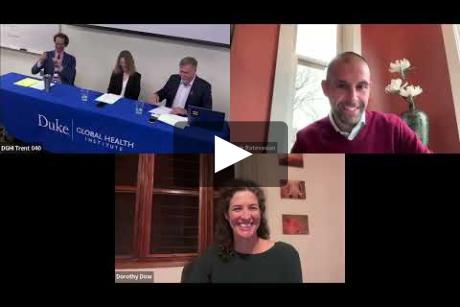
Manish and Denali at the Ministry of Health, Peru, to meet with the Executive Director of the Telemedicine Department.
Published June 22, 2016, last updated on October 17, 2017 under Voices of DGHI
By Manish Nair (Pratt 2017)
“What new technologies could we develop to improve the way you deliver care?”
We had the privilege of presenting the POCkeT colposcope to some of the residents in Family Medicine at Polyclinico Juan Jose Rodriguez Lazo, at the behest of Dr. Fuentes, whom we met when she was a guest speaker at Duke Hospital. It was heartening to see the residents were excited about the potential of the device, but the moment I took away from the session was the residents’ response when I asked the question above. They came alive, and seemingly each of them had multiple ideas about how their practice could be better supported with technology.
There were a range of suggestions from developing a basic electronic health record (which does not exist in most clinics in Peru) to an affordable ultrasound device that was portable. One of the residents expressed “everything can be improved, and anything could make a difference.” Building technology to improve healthcare is my passion as a biomedical engineer and knowing these needs exist added to my resolve.
It was fitting that I had a meeting immediately after the presentation which dealt with Peruvian initiatives to transform healthcare with technology. One meeting was with Dr. Rojas, the Executive Director of the Telemedicine Department of the Peruvian Ministry of Health. It was amazing to hear about the work being done out of this department. In essence, the Telemedicine Department aims to increase the range of services available at every public clinic nationally and connects these clinics via networks.
For example, if a clinic in Pueblo Libre needed a pediatric specialist to diagnose and treat a patient but it did not have one present, a remote consultation could be set up with a specialist from a different clinic through a teleconference. Many of these networks are set up around the country and enhances healthcare capabilities especially in the smaller towns. Of course, a teleconference is not nearly the same quality as having a specialist available at the clinic in person, but it has certainly been an effective solution while the larger systemic shortages are being addressed.
Dr. Rojas also conceded that connectivity was an issue but asserted that fiber-optic infrastructure was being developed to better connect most of the networks. In the more inaccessible areas of Peru, such as the jungle and mountain terrains, radio-wave communication is being used to some degree of success. In spite of the challenges faced, it was inspiring to hear about how the Telemedicine Department is utilizing technology to enhance the national healthcare delivery system.


